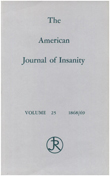Prospective clinicopathologic studies of schizophrenia: accrual and assessment of patients
Abstract
OBJECTIVE: The purpose of this study was to characterize the neuropsychiatric profile of elderly patients with schizophrenia and establish a patient registry for prospective ante-mortem and post- mortem studies. METHOD: Medical records of all chronically institutionalized patients in eight state hospitals who were over the age of 65 and had a chart diagnosis of schizophrenia (N = 528) were reviewed. Of the potential subjects, 192 were excluded because of clinical histories inconsistent with a diagnosis of schizophrenia, 56 because of insufficient information to establish a psychiatric diagnosis, and 122 because of family members' refusal to give consent for autopsy in the event of death. To date, 81 of the remaining 158 patients have undergone neuropsychiatric evaluation with standard assessment instruments. RESULTS: Mini-Mental State scores of the 81 patients indicated severe dementia, and Functional Assessment Scale scores showed that patients required assistance with activities of daily living. All patients were rated as severely ill on the Brief Psychiatric Rating Scale. Ratings on the Scale for the Assessment of Negative Symptoms and the Scale for the Assessment of Positive Symptoms indicated a predominance of negative symptoms over positive. Of 30 patients who have died to date, research autopsies have been conducted on 26. CONCLUSIONS: Establishing a well characterized, prospective patient registry for clinicopathologic studies of schizophrenia is feasible but labor intensive. Diagnosis of schizophrenia with a high degree of confidence can be achieved by means of detailed chart review and assessment of current neuropsychiatric functioning with standard rating instruments. These data provide a basis for correlations of clinicopathologic factors.
Access content
To read the fulltext, please use one of the options below to sign in or purchase access.- Personal login
- Institutional Login
- Sign in via OpenAthens
- Register for access
-
Please login/register if you wish to pair your device and check access availability.
Not a subscriber?
PsychiatryOnline subscription options offer access to the DSM-5 library, books, journals, CME, and patient resources. This all-in-one virtual library provides psychiatrists and mental health professionals with key resources for diagnosis, treatment, research, and professional development.
Need more help? PsychiatryOnline Customer Service may be reached by emailing [email protected] or by calling 800-368-5777 (in the U.S.) or 703-907-7322 (outside the U.S.).



